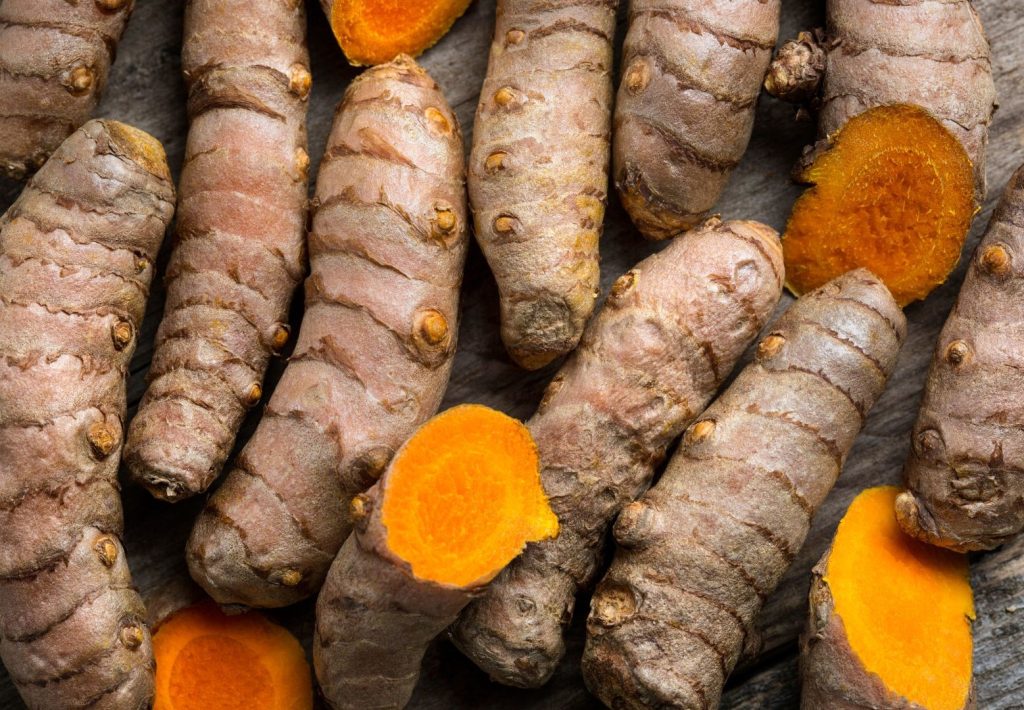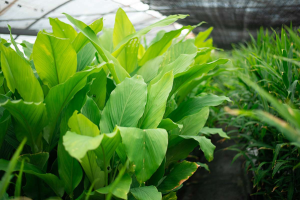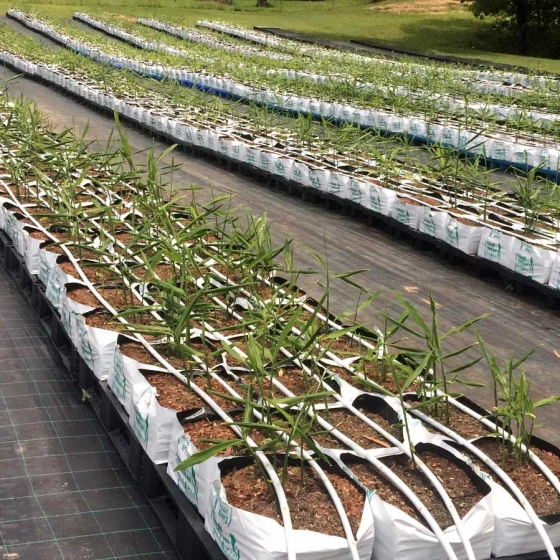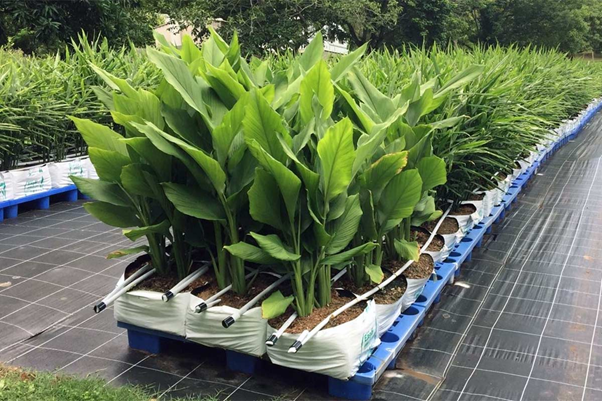Soilless Turmeric Cultivation
Turmeric is a crop known for its medicinal properties and culinary significance. It’s a member of the ginger family (Zingiberaceae) and is scientifically known as Curcuma longa. There are multiple varieties of turmeric, each with unique pros and cons. For instance, black turmeric is dark blue instead of the usual golden orange. This type is not typically used for culinary purposes but for medicinal purposes, such as treating cancer, due to its abundance of over 30 bioactive compounds. Every farmer should thoroughly examine the different varieties and types before starting turmeric cultivation.
Additionally, the environment in which turmeric is grown heavily impacts the yield and percentage of bioactive compounds. For instance, some varieties grow in harsh, sunny climates, while others thrive in cool, hilly environments. As a result, more people are starting cultivation turmeric in ways that minimize external factors that might interfere with the growing process. Soil-less cultivation has emerged as a popular method to achieve these goals.


Is Soilless Cultivation the Same as Hydroponics?
Although they may appear indistinguishable, it’s worth noting that “all hydroponic systems are soilless, but not all soilless systems can be classified as hydroponic. This is due to the constraints of growing root crops, such as tubers, which cannot be cultivated using hydroponic systems. However, it’s possible to nurture root crops in a cocopeat or other soilless media through a grow bag or trough, with nutrient delivery facilitated by a drip irrigation system.

Turmeric cultivation in a soilless system
As previously mentioned, growing turmeric using a soilless system is possible. The primary advantages of this method include:
- Mitigating the risk of soil-borne diseases.
- Minimizing damage from rain by utilizing a controlled environment.
- Producing high-quality rhizomes (end product).
Moreover, the yield from cultivating turmeric in a soilless system can reach up to 50 times more than that of traditional soil-based cultivation, which typically yields only 10 times more. For instance, if 100 grams of seeds were used, the yield could be approximately 5000 grams. Note: 100 grams of seeds does not mean from a single plant.
Media composition for cultivating turmeric
Numerous studies have concluded that turmeric and ginger grow well in soilless media. It has been recommended to grow them in sterile media such as cocopeat. Some studies suggest adding sand in the following proportion: 1 part cocopeat, 1 part burnt rice husk, and 1 part sand. Others propose using 75% cocopeat and 25% soil. Beginners should start with only coco peat due to the potential risks associated with burnt rice husk and soil. Once you have gained experience with coco peat cultivation, you can experiment with other mediums to reduce capital expenses.

TDS, EC, and PPM terms explained
These measurements will indicate the total amount of salts (nutrients) in the water rather than the levels of individual elements such as N, P, K, etc. Open-source software such as HydroBuddy can help formulate nutrients based on fertilizer availability and required macro and micronutrient levels.
In this field, various methods exist for measuring the nutrients given to plants. TDS (Total Dissolved Salts) is a common method where PPM (Parts Per Million) is the unit of measurement. EC (Electrical Conductivity) is another method, and it is measured in two units: Millisiemens (mS) and Microsiemens (µS). Some individuals also use CF (Conductivity Factor). It’s simple to convert between these units: 1 mS = 1000 µS, and 1 mS = 640 PPM (~700 PPM).
Note: Milligram per liter is equivalent to PPM(1 mg/l=~1 ppm)
Nutrient composition for turmeric plants
The crop cycle can be divided into two primary stages:
- vegetative
- rhizome (root) development (reproductive)
During the vegetative stage, plants require more nitrogen to promote foliage growth. However, nitrogen levels must be reduced during the rhizome development stage, and potassium levels should be increased to facilitate root growth. During the early periods of the vegetative stage, the levels of micronutrients such as iron, manganese, and boron are required. It is recommended to gradually increase the electrical conductivity (EC) while ensuring it doesn’t surpass 2.6 mS throughout the cycle.
The optimal macronutrient levels are as follows:
- Nitrogen (170-180 ppm),
- Phosphorus (110-120 ppm), and
- Potassium (200-240 ppm)
The secondary nutrient levels should also range between 220-230 ppm for Calcium and 40-55 ppm for Magnesium. Furthermore, the micronutrient levels should fall within the following range:
- Iron (4-6 ppm),
- Manganese (3 ppm),
- Zinc (0.25 ppm),
- Boron (0.7 ppm),
- Copper (0.07 ppm), and
- Molybdate (0.06 ppm)
It’s important to remember that pH is a crucial factor that should not be overlooked. While pH levels vary from crop to crop, the ideal range is between 5.5 to 6.5. Maintaining balanced pH levels is critical because it determines whether the mixed nutrient stays dissolved in the solution and is absorbable by the plant. Chelated micronutrients can be used. The major advantage is that chelated micronutrients do not chemically react with other nutrients and stay dissolved even if the pH is unbalanced.

Ideal growing conditions for growing turmeric
Turmeric requires a photoperiod of approximately 11 hours and partial shade, making using a shade net desirable. Additionally, it thrives in temperatures ranging from 26-35 degrees Celsius, with leaf temperatures not exceeding 30 degrees Celsius; if it does, the leaves may curl up, and photosynthetic efficiency will decrease. While some may overlook the CO2 factor, increasing the CO2 PPM can help to enhance the photosynthetic rate, even if the leaf temperature surpasses the limit. Ideally, humidity should be maintained between 70-90%; if it falls below this range, leaves may age prematurely and yellow. Conversely, if humidity remains too high for extended periods, plants may be prone to
airborne diseases, such as leaf blotch. The recommended plant-to-plant spacing for optimal growth is 30-35 cm, and zig-zag sowing can increase plant count.
Major Pests and Diseases in Turmeric
While Controlled Environment Agriculture (CEA) is designed to mitigate pests, minor structural issues can still lead to infestations. The most common pests in soilless turmeric sultivation are Grasshoppers, Caterpillars, Mites, and Lacewing bugs. Additionally, while not directly harmful to crops, ants can act as vectors, spreading pests such as mealybugs and mites between plants.
Therefore, controlling vector pests is equally crucial to controlling actual pests. Furthermore, airborne diseases like leaf blotch, leaf spot, and rust are prevalent in high-humidity environments.
My Personal experience working with turmeric plant
I attribute a significant portion of my personal growth to Mr. CV Prakash, a pioneer of hydroponics in India. His groundbreaking work in soilless turmeric and ginger cultivation has inspired me significantly. Although soilless cultivation may seem daunting, growing root crops this way is not as challenging as it appears. Those who enter the field solely for monetary returns, without paying attention to the science, often fail. On the other hand, individuals who possess a deep interest in the science behind hydroponics succeed. Therefore, I recommend starting with a small trial plot to learn the science before scaling up commercially. It’s essential to take precautionary measures to address any issues encountered in the trial plot.
Reference
- Effects of substrates on growth and yield of ginger cultivated using soilless culture(J. Trop. Agric. and Fd. Sc. 40(2)(2012): 159– 168)
- Effects of Different Soilless Media and Planting Density on the Flower and Rhizome Yield of Curcuma alismatifolia(Trans. Malaysian Soc. Plant Physiol. 25 First Published, 2018 )
- Productivity potential and efficiency and economic feasibility of tomato-based intercropping systems in solid soilless media under protected condition (Journal of Pharmacognosy and Phytochemistry 2019; 8(2): 604-609)
- Aeroponic Cultivation of Ginger (Zingiber officinale) Rhizomes(Hayden, A. L., Brigham, L. A., & Giacomelli, G. A. (2004))
Image credits : Galuku,Gilles San Martin.










































































